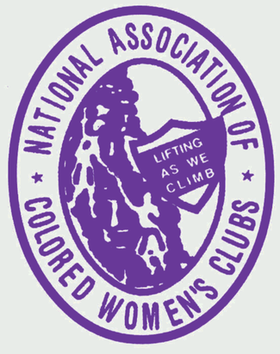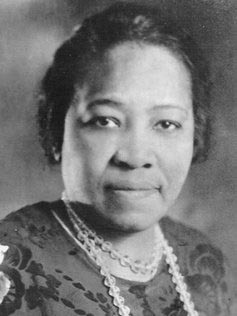
Carrie Chapman Catt was an American women's suffrage leader who campaigned for the Nineteenth Amendment to the United States Constitution, which gave U.S. women the right to vote in 1920. Catt served as president of the National American Woman Suffrage Association from 1900 to 1904 and 1915 to 1920. She founded the League of Women Voters in 1920 and the International Woman Suffrage Alliance in 1904, which was later named International Alliance of Women. She "led an army of voteless women in 1919 to pressure Congress to pass the constitutional amendment giving them the right to vote and convinced state legislatures to ratify it in 1920" and "was one of the best-known women in the United States in the first half of the twentieth century and was on all lists of famous American women."

The National Association of Colored Women's Clubs (NACWC) is an American organization that was formed in July 1896 at the First Annual Convention of the National Federation of Afro-American Women in Washington, D.C., United States, by a merger of the National Federation of Afro-American Women, the Woman's Era Club of Boston, and the Colored Women's League of Washington, DC, at the call of Josephine St. Pierre Ruffin. From 1896 to 1904 it was known as the National Association of Colored Women (NACW). It adopted the motto "Lifting as we climb", to demonstrate to "an ignorant and suspicious world that our aims and interests are identical with those of all good aspiring women." When incorporated in 1904, NACW became known as the National Association of Colored Women's Clubs (NACWC).
The following is a timeline of the history of the city of Des Moines, Iowa, USA.

Elizabeth Piper Ensley, was an educator and an African-American suffragist. Born in Massachusetts, Ensley was a teacher on the eastern coast of the country. She moved to Colorado where she achieved prominence as a leader in the Colorado suffrage movement. She was also a journalist, activist, and a leader and founder of local women's clubs.

Ida Sedgwick Proper was an American suffragist, writer and artist. She was an art editor for The Woman Voter. Proper has work in the permanent collections of the Smithsonian, and the Des Moines Art Center.

The Northeastern Federation of Colored Women's Clubs (NFCWC) is an umbrella organization representing black women's clubs in the northeastern United States. The organization was affiliated with the National Association of Colored Women's Clubs (NACWC). It was the first umbrella organization for black women's clubs in the United States, predating the NACWC by a month. The motto of the club is "For God and Humanity".
The Charlotte Woman's Club (CWC) is the oldest civic organization in Charlotte, North Carolina. Charlotte Woman's club was and still is very active in the community. They established the first kindergarten in the city. During both world wars, they staffed city buses and the Southern Railway station with volunteers. They were also involved with organizing the YWCA, PTA and Traveler's Aid in Charlotte. They also brought the first public health nurses to Charlotte and helped create the League of Women Voters. The CWC also supported the creation of the Mint Museum of Art and the Domestic Relations Court.
The Texas Association of Women's Clubs (TAWC) is an umbrella organization of African American women's clubs in Texas. It was first organized as the Texas Federation of Colored Women's Clubs in 1905. The purpose of the group was to allow clubs to work together to improve the social and moral life of people in Texas. The club also spoke on topics of interest to black women in the United States.

Victoria Clay Haley, later Victoria Clay Roland, was an American suffragist, clubwoman, bank executive, and fundraiser based in St. Louis, Missouri and later in Chicago.

Mary Garrett Hay was an American suffragist and community organizer. She served as president of the Women's City Club of New York, the Woman Suffrage Party and the New York Equal Suffrage League. Hay was known for creating woman's suffrage groups across the country. She was also close to the notable suffragist, Carrie Chapman Catt, with one contemporary, Rachel Foster Avery, stating that Hay "really loves" Catt.
The Woman's Era Club was an African-American women's civic organization founded in Boston, Massachusetts, in between 1892 and 1894 by Josephine St. Pierre Ruffin. The Club was the first black women's club in Boston. The organization was especially well-known for the conflict caused when Ruffin attempted to desegregate the General Federation of Women's Clubs (GFWC) in 1900.
Dorothy Deemer Houghton was an American Republican public official and civil servant.

Eva Carter Buckner was a prominent African-American suffragist, poet, and songwriter.

Maude Brockway was an American teacher, milliner, and activist. She was born in Arkansas in 1876 and moved to Indian Territory after completing her education at Arkansas Baptist College. Initially, she worked as a teacher around Ardmore, Chickasaw Nation and then opened a hat-making business. In 1910, she moved to Oklahoma City and became involved in the Black Clubwomen's Movement. She was one of the founders of the state affiliate, Oklahoma Federation of Colored Women's Clubs and city chapter, Oklahoma City Federation of Colored Women's Clubs of the National Association of Colored Women's Clubs. She served as president of the city chapter from 1925 to 1950 and of the state federation from 1936 to 1940, as well as holding offices in the national organization.

Women's suffrage in Illinois began in the mid 1850s. The first women's suffrage group was formed in Earlville, Illinois by the cousin of Susan B. Anthony, Susan Hoxie Richardson. After the Civil War, former abolitionist, Mary Livermore, organized the Illinois Woman Suffrage Association (IWSA) which would later be renamed the Illinois Equal Suffrage Association (IESA). Frances Willard and other suffragists in the IESA worked to lobby various government entities for women's suffrage. In the 1870s, women were allowed to serve on school boards and were elected to that office. The first women to vote in Illinois were 15 women in Lombard, Illinois led by Ellen A. Martin who found a loophole in the law in 1891. Women were eventually allowed to vote for school offices in the 1890s. Women in Chicago and throughout Illinois fought for the right to vote based on the idea of no taxation without representation. They also continued to expand their efforts throughout the state. In 1913, women in Illinois were successful in gaining partial suffrage. They became the first women east of the Mississippi River to have the right to vote in Presidential elections. Suffragists then worked to register women to vote. Both African-American and white suffragists registered women in huge numbers. In Chicago alone 200,000 women were registered to vote. After gaining partial suffrage, women in Illinois kept working towards full suffrage. The state became the first to ratify the Nineteenth Amendment, passing the ratification on June 10, 1919. The League of Women Voters (LWV) was announced in Chicago on February 14, 1920.

Sue M. Wilson Brown was an African-American activist for women's suffrage. She was inducted into the Iowa Women's Hall of Fame in 1995.

Women's suffrage in Iowa efforts began early in Iowa's history. During the territory's Constitutional Convention, discussions on both African American and women's suffrage took place. Early on, women's rights were discussed in the state by women such as Amelia Bloomer and petitions for suffrage were sent to the Iowa state legislature. While African American men earned the right to vote in 1868, women from all backgrounds had to continue to agitate for enfranchisement. One of the first suffrage groups was formed in Dubuque in 1869. Not long after, a state suffrage convention was held in Mount Pleasant in 1870. Iowa suffragists focused on organizing and lobbying the state legislature. In 1894, women gained the right to vote on municipal bond and tax issues and also in school elections. These rights were immediately utilized by women who turned out in good numbers to vote on these issues. By the 1910s, the state legislature finally passed in successive sessions a women's suffrage amendment to the state constitution. This resulted in a voter referendum to be held on the issue on June 5, 1916. The campaign included anti-suffrage agitation from liquor interests who claimed that women's suffrage would cause higher taxes. The amendment was defeated, though a subsequent investigation turned up a large amount of fraud. However, the election could not be invalidated and women had to wait to vote. On July 2, 1919, Iowa became the tenth state to ratify the Nineteenth Amendment.

This is a timeline of women's suffrage in Iowa. Women's suffrage work started early in Iowa's history. Organizing began in the late 1960s with the first state suffrage convention taking place in 1870. In the 1890s, women gained the right to vote on municipal bonds, tax efforts and school-related issues. By 1916, a state suffrage amendment went to out to a voter referendum, which failed. Iowa was the tenth state to ratify the Nineteenth Amendment in 1919.
















